The beloved upright piano occupies a special corner in countless households and institutions worldwide, enchanting with its exquisite sound and meticulous artistry. A crucial aspect contributing to its functionality and placement is its dimensions. Understanding these dimensions is essential for anyone looking to buy or accommodate a piano, as it impacts the instrument’s sound quality, the space it occupies, and its overall aesthetic appearance within a room. This article explores the typical dimensions of an upright piano, offering valuable insights and guidance for both aspiring and current piano owners.
What Is An Upright Piano?
An upright piano, also referred to as a vertical piano, is a piano design in which the soundboard and strings are positioned vertically. This configuration distinguishes it from other types of pianos. This design makes it more compact than grand pianos, allowing it to fit into smaller spaces while still delivering exceptional sound quality. The upright piano comes in various sizes, but its distinguishing feature remains its vertical structure, offering a balance of space economy and musical performance. With its sleek and space-saving design, along with its immersive and vibrant sound, it has become a favored option for residences, educational institutions, and intimate performance spaces.
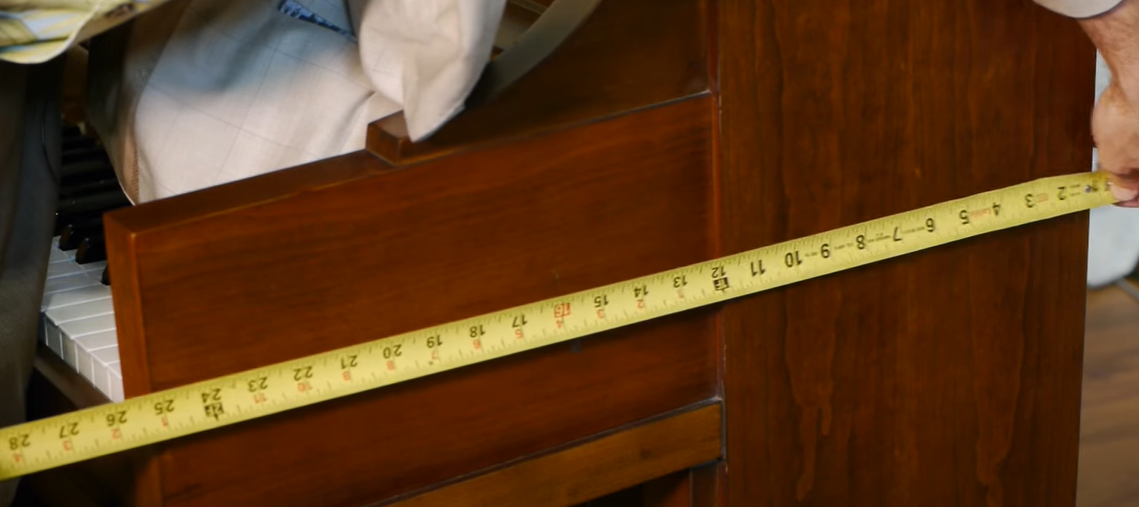
What Is The Difference Between An Upright And Grand Piano?
The key differentiating factor between an upright piano and a grand piano lies in their structural design and the arrangement of their strings. A grand piano features horizontal strings that extend from the keyboard, enabling longer string length and a larger soundboard. This design contributes to a richer sound and greater dynamic range, making grand pianos a staple in professional concert settings. Conversely, an upright piano, with its vertically oriented strings and compact design, is engineered for smaller spaces. While it may not offer the same tonal range as a grand piano, its sound quality is exceptional, particularly in the mid-range tones. Moreover, owing to its compact size, an upright piano is often more budget-friendly, making it a favored option for residential settings, educational institutions, and intimate venues. [1]
Largest To Smallest Upright Pianos
Upright pianos come in a range of sizes, each with its unique characteristics.
Upright Piano
The term “Upright Piano” denotes the ubiquitous standard upright piano, prevalent in residences, educational institutions, and intimate music venues. Its height usually ranges between 110 to 135 centimeters (43 to 53 inches), and its width is typically about 155 centimeters (61 inches). The depth of an upright piano, which refers to the distance from the back of the piano to the keys, is usually about 60 centimeters (24 inches). Although compact, the upright piano is celebrated for its rich, resonant sound, rivaling that of a grand piano, while also maximizing space efficiency. It is ideal for those seeking a high-quality instrument that fits comfortably within a smaller area.
Studio Piano
The Studio Piano is an expanded rendition of the conventional upright piano, typically measuring 112 to 121 centimeters (44 to 48 inches) in height. The width of the standard upright remains fairly consistent, measuring about 155 centimeters (61 inches). The depth of the upright piano is approximately 60 centimeters (24 inches), similar to its width. The increased height of the studio piano permits a larger soundboard and longer strings, enhancing its tonal quality and volume. These pianos are often found in music studios and classrooms, where a more robust sound projection is beneficial. Despite requiring slightly more space, the studio piano offers an impressive sound quality, making it a favorite amongst professional musicians and educators. [2]
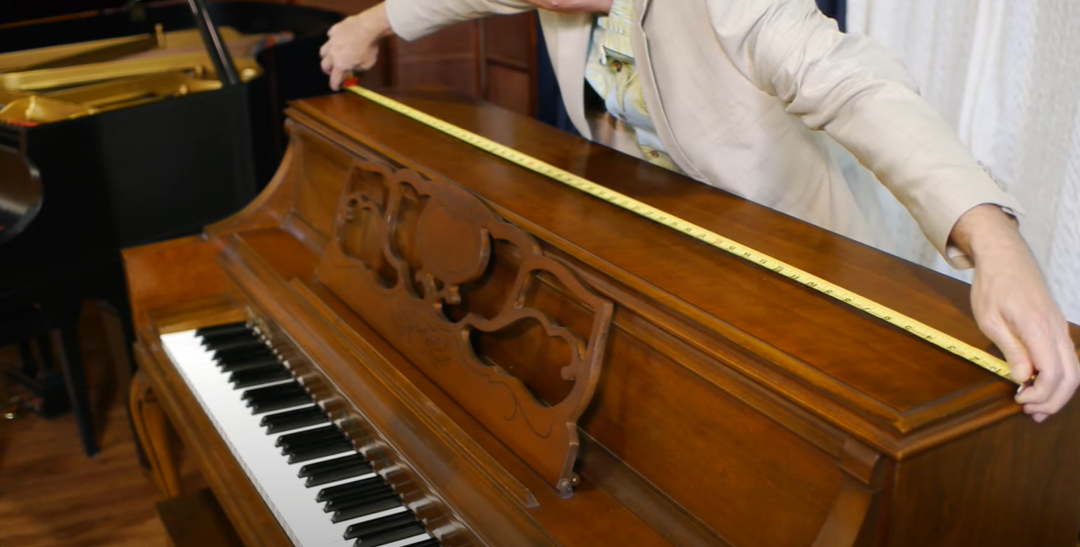
Console Piano
The Console Piano is a more diminutive version of the upright piano, with a height generally between 100 to 110 centimeters (40 to 43 inches). The width and depth are consistent with the standard upright and studio pianos, measuring around 155 centimeters (61 inches) and 60 centimeters (24 inches) respectively. Although smaller in size, console pianos do not compromise on sound quality. Their design integrates well into domestic settings due to their stylish cabinets and smaller stature. Console pianos are a perfect option for those seeking an instrument that can produce a rich and full-bodied sound, even in homes and smaller music studios where space is limited.
Spinet Piano
The Spinet Piano is the smallest among the upright piano family, standing typically at a height of 90 to 100 centimeters (36 to 39 inches). Its width and depth are similar to other upright pianos, with a width of around 155 centimeters (61 inches) and a depth of approximately 60 centimeters (24 inches). Due to its smaller size, a spinet piano has shorter strings and a smaller soundboard, which may slightly compromise its sound quality compared to larger upright pianos. However, its compact size makes it an excellent fit for small rooms and apartments, making it a popular choice for those with significant space constraints. Despite a more limited tonal range, the spinet piano still produces a pleasant sound, making it suitable for novice pianists and casual playing. [3]
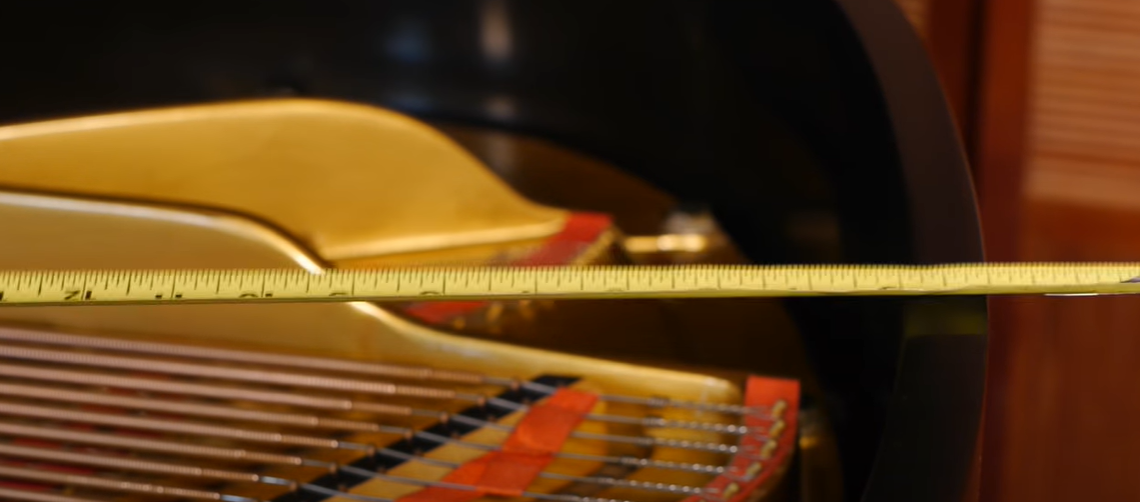
How Wide Is An Upright Piano?
The width of an upright piano remains fairly consistent across all types, typically measuring around 155 centimeters (61 inches). This standard width applies regardless of the piano’s height, helping to maintain a uniform keyboard size, which is crucial for consistent playability. The width is less influential on the piano’s sound quality compared to height or depth, but it’s essential for determining the space needed to accommodate the instrument. Always remember to measure your available space before buying a piano, ensuring it will fit comfortably without obstructing pathways or cramping the room.
How Much Does An Upright Piano Weigh?
The weight of an upright piano can greatly differ based on its size and the materials used in its construction. Typically, an upright piano has a weight ranging from 200 to 400 kilograms (440 to 880 pounds). A smaller spinet piano, for instance, may weigh as little as 180 kilograms (400 pounds), while a larger studio piano can weigh up to 500 kilograms (1100 pounds). The weight of a piano is a crucial factor to consider when planning its placement and transportation, as it can impact the stability of the floor and the ease of moving the instrument. It’s also worth bearing in mind that the weight of the piano can affect its sound, with heavier pianos often providing a richer and fuller tone. [4]
FAQ
How much space does an upright piano take?
An upright piano, regardless of its specific type, typically requires a space of at least 155 centimeters (61 inches) wide and 60 centimeters (24 inches) deep to accommodate the instrument itself. However, additional space should be factored in to allow for comfortable seating and movement around the instrument, as well as acoustic considerations. Ideally, there should be at least 1-2 feet of space on each side of the piano, and it should be placed against an interior wall to protect it from temperature and humidity fluctuations. Therefore, a more realistic estimate of the space taken by an upright piano would be around 200 centimeters (79 inches) wide and 100 centimeters (39 inches) deep. Before buying a piano, it’s crucial to measure your available space to ensure a perfect fit. This simple step will guarantee that you make the right choice and avoid any potential issues.
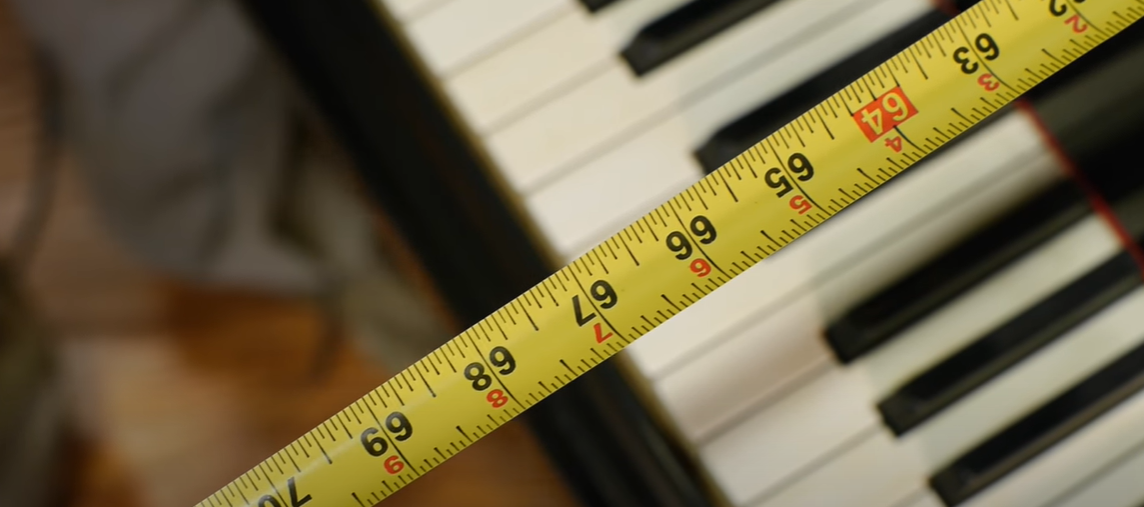
What is the minimum width of an upright piano?
The minimum width of an upright piano typically hovers around 145 centimeters (57 inches). However, the standard width across various types of upright pianos is commonly 155 centimeters (61 inches). The width of the piano is maintained to ensure a standard keyboard size for optimal playability. Despite the slight variation in minimal width, it’s essential to measure the intended placement area for the piano to ensure a comfortable fit.
What does the standard size piano have?
The standard size piano, often referred to as the upright piano, typically stands around 110 to 135 centimeters (43 to 53 inches) tall, with a width of approximately 155 centimeters (61 inches) and a depth of about 60 centimeters (24 inches). This size allows for a good balance between sound quality and space efficiency. The standard size piano features a large soundboard and longer strings than its smaller counterparts, contributing to a rich, full-bodied sound. Additionally, it maintains a standard keyboard size for consistent playability. Its size and weight, while substantial, are generally manageable for most domestic settings. Therefore, the standard size piano offers a blend of high-quality sound production, aesthetic appeal, and versatile placement options, making it a favored choice for a wide array of piano enthusiasts.
How big is an upright piano in CM?
The dimensions of an upright piano in centimeters typically range as follows: the height can be anywhere between 110 to 135 centimeters; the width is generally around 155 centimeters, and; the depth usually measures about 60 centimeters. These dimensions, of course, can vary slightly depending on the specific type of upright piano, but these are the standard measurements you can expect. Always ensure to measure your available space before purchasing an upright piano to guarantee a perfectly snug fit.
What is a full size piano?
A concert grand piano, also referred to as a full-size piano, represents the largest category of pianos in existence. This instrument typically measures around 2.75 meters (9 feet) in length. The term “full size” commonly denotes a keyboard with 88 standard-sized keys, comprising 52 white keys and 36 black keys. This comprehensive layout ensures a complete playing experience. This range allows for the vast majority of music compositions to be played. As with all pianos, the larger size of the concert grand allows for longer strings and a larger soundboard, which contributes to its powerful, rich, and resonant sound. These pianos are commonly seen in professional concert venues and are favored by accomplished pianists for their exceptional musical capabilities. However, due to their size, they require a significant amount of space and may not be suitable for smaller rooms or residential settings. Always consider your available space before purchasing a full-size piano. So, whether you’re an aspiring pianist or a music enthusiast looking for a beautiful and versatile instrument, the upright piano is an excellent choice.
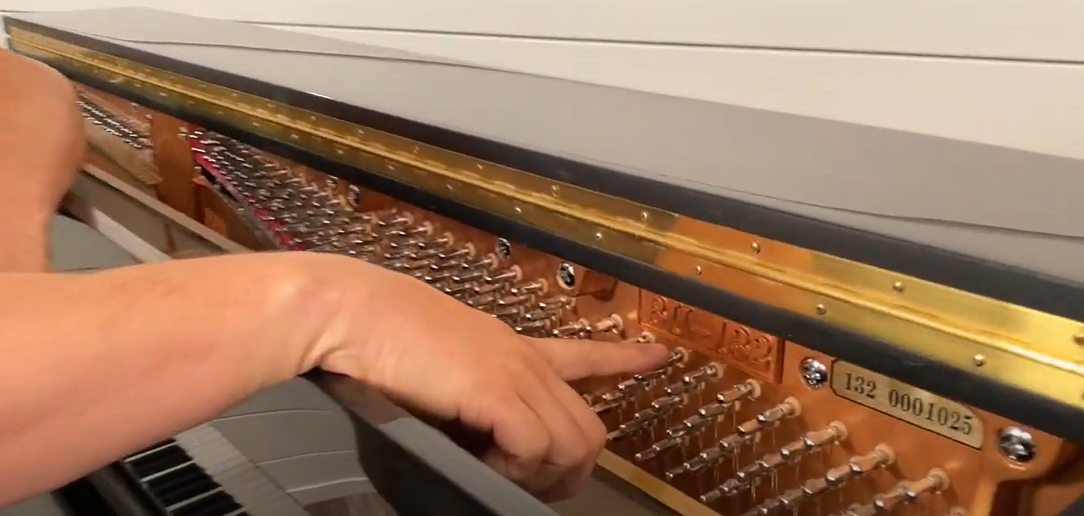
Will an upright piano fit through a door?
Whether an upright piano will fit through a door largely depends on the dimensions of both the piano and the door. In most homes, the typical width of a door falls between 76 to 81 centimeters (30 to 32 inches). Conversely, the depth of an upright piano is generally around 60 centimeters (24 inches). This suggests that, in most cases, an upright piano should be able to fit through a standard-sized door when moved carefully on its side. However, it’s vital to consider other factors such as the piano’s height, the door’s height, and any turns or obstacles in the moving path. Therefore, always measure both the piano and the door opening beforehand to ensure a smooth moving process. Additionally, professional piano movers can be hired to safely navigate these challenges and prevent potential damage to the instrument. So, if you’re planning to move a piano through a door, it’s always best to consult and seek assistance from experts. Overall, with proper care and planning, an upright piano can be safely moved through a standard-sized door.
How tall is the piano cm?
The height of an upright piano, also known as its tallness, typically ranges between 110 to 135 centimeters. However, it’s worth noting that these dimensions can vary. A smaller, spinet piano can stand as short as 90 centimeters, while a larger, professional upright piano can reach up to 132 centimeters. Always check the specific measurements of the piano model in question to ensure it fits into your designated space. Furthermore, the height of a piano is closely related to its sound quality; taller pianos typically produce a fuller and more resonant sound due to their larger soundboards and longer strings. Therefore, it’s essential to consider both space limitations and desired sound quality when choosing an upright piano. Therefore, it is crucial to consider your preferences and the availability of space before finalizing a purchase decision. With proper measurement and planning, you can ensure that your upright piano will fit comfortably in your home and provide you with hours of musical enjoyment.
How long is a piano dimension?
The length of a piano, often referred to as its depth, largely depends on the type of piano in question. For an upright piano, the usual depth measures around 60 centimeters (24 inches), while for grand pianos, the length can drastically vary. A baby grand piano, for instance, can measure approximately 1.5 meters (5 feet) long. In contrast, a concert grand can extend up to 2.75 meters (9 feet) in length, making it the longest type of piano. Always remember to account for this dimension when planning the piano’s placement. The depth or length of the piano not only impacts the space it will occupy but also influences the instrument’s sound quality, as longer strings produce a richer, deeper resonance. Therefore, the piano’s dimensions play a crucial role in both its appearance and musical capabilities. Having a comprehensive understanding of the standard dimensions of an upright piano is crucial when contemplating its purchase or placement within your home or space. By being aware of their size and potential placement challenges, you can ensure a comfortable fit, optimal playability, and an aesthetically pleasing addition to any room. Whether you choose a standard or concert grand piano, understanding their dimensions will guide your decision-making and enhance your appreciation of their musical potential.
How are upright pianos measured?
Upright pianos are measured using three key dimensions: height, width, and depth. The height of the piano is determined by measuring from the floor to the highest point of the instrument. The width is the measurement from left to right across the keyboard, while the depth is measured from the front to the back of the piano. It’s important to note that the depth is often referred to as the piano’s ‘length’. When taking these measurements, one must ensure that the tape measure is straight and level for accuracy. Additionally, it is important to check the manufacturer’s specifications as they will provide the most accurate dimensions. Remember that these measurements are crucial when planning the transportation and placement of the piano in your home or venue. Before making a purchase, it is wise to measure the available space and compare it with the dimensions of the piano. This ensures the best fit and avoids any potential issues. Plus, this will also ensure that there is enough room for any additional accessories, such as a bench or music stand.
Useful Video: What Are The Different Sizes of Upright Pianos?
Conclusion
In conclusion, understanding the dimensions of upright pianos is a crucial aspect of buying, positioning, and appreciating these magnificent musical instruments. Sizes can vary, ranging from smaller, spinet pianos to larger, professional upright and concert grand pianos. The height, width, and depth (often referred to as the ‘length’) of a piano significantly influence not only its placement but also its sound quality. Larger pianos typically deliver a fuller, more resonant sound due to their longer strings and larger soundboards. Therefore, it’s necessary to balance space constraints with desired sound quality when choosing a piano. Always remember to take into account the doorways and potential obstacles when planning the piano’s transportation. Knowledge about these standard measurements will equip you with the information needed to make an informed decision, helping to ensure that your chosen piano is a comfortable fit and a joy to play.
References:
- https://rogers-piano.com/piano_newsletter/standard-upright-piano-dimensions/
- https://www.musicalhow.com/upright-piano-types-sizes/
- https://zinginstruments.com/types-of-upright-pianos/
- https://www.pianomalaysia.com/new/blog-understanding-upright-piano-types-and-sizes/





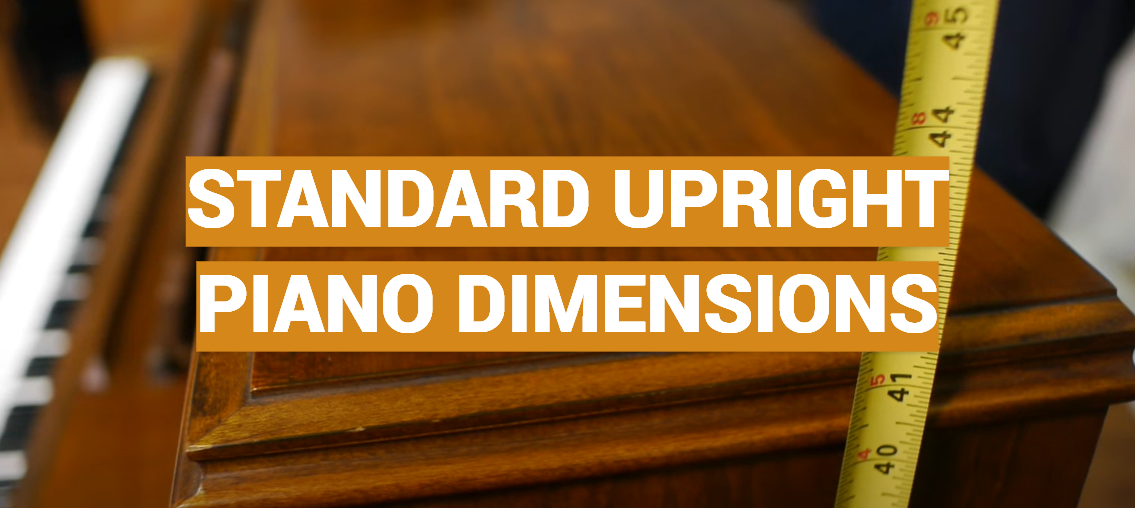




Leave a Reply